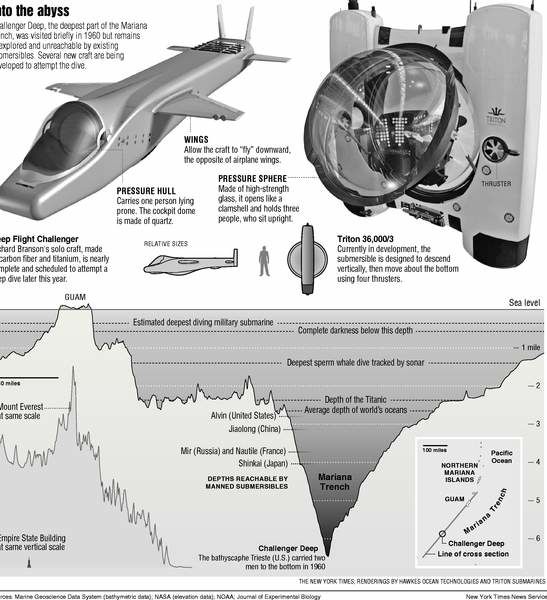Daredevils have ambitions as deep as their pockets
Published 5:00 am Tuesday, August 2, 2011

- Daredevils have ambitions as deep as their pockets
A new generation of daredevils is seeking to plunge through nearly seven miles of seawater to the bottom of a rocky chasm in the western Pacific that is veiled in perpetual darkness. It is the ocean’s deepest spot. The forbidding place, known as the Challenger Deep, is so far removed from the warming rays of the sun that its temperature hovers near freezing.
“When I was a kid, I loved not only amazing ocean exploration but space, too,” James Cameron, the director of “Avatar,” “Titanic” and “The Abyss,” said in an interview. “I can think of no greater fantasy than to be an explorer and see what no human eye has seen before.”
The would-be explorers can afford to live their dreams because of their extraordinarily deep pockets. Significantly, their ambitions far exceed those of the world’s seafaring nations, which have no plans to send people so deep.
The billionaires and millionaires include Cameron, airline mogul Richard Branson and Internet guru Eric Schmidt. Each is building, planning to build or financing the construction of minisubmarines meant to transport them, their friends and scientists into the depths. Entrepreneurs talk of taking tourists down as well.
The vehicles, meant to hold one to three people, are estimated to cost anywhere from $7 million to $40 million.
The first dive is scheduled for later this year. Since secrecy and technical uncertainty surround many of the ventures, oceanographers say the schedules may well change.
The rush is happening now in part because of advances in materials, batteries and electronics, which are lowering the cost and raising the capabilities of submersibles. Still, the challenges are formidable.
Hardest to build are the crew compartments, whose walls must be very thick, strong and precisely manufactured to withstand tons of crushing pressure. Designers are using not only traditional steel but such unexpected materials as spheres of pressure-resistant glass.
Humans have laid eyes on the Challenger Deep just once, half a century ago, in a U.S. Navy vessel. A window cracked on the way down. The landing on the bottom stirred up so much ooze that the two divers could see little and took no pictures. They stayed just 20 minutes.
In early April, Branson held a news conference in Newport Beach, Calif., to unveil his submersible.
“The last great challenge for humans,” said Branson, the founder of Virgin Atlantic and Virgin Galactic, “is to explore the depths of our planet’s oceans.”
His solo craft, nearly 18 feet long, looked like a white-and-blue airplane with stubby wings and a cockpit.
The winged craft and its mother ship cost an estimated $17 million. The submersible is scheduled to plunge deep this year, its pilot a colleague of Branson.
A few weeks later, in late April, another team went public. It unveiled plans, rather than a nearly complete vehicle. The company, Triton Submarines, based in Vero Beach, Fla., makes tiny submersibles with acrylic personnel spheres that carry two people down a half mile or more. The clear spheres provide much better viewing than the tiny portholes of traditional submersibles.
The company announced that it was ready to build a submersible — costing $15 million — to carry three people into the Challenger Deep. The vehicle’s personnel sphere — 71⁄2 feet in diameter — would be made entirely of glass and open like a clamshell to admit passengers.
Cameron, the maker of Hollywood blockbusters, has kept a low profile and based his effort in Australia. About five years ago, he formed a team that has been quietly building a submersible along traditional lines, only smaller.
The sphere underwent a successful pressure test in September 2009, Cameron said. He said his team had overcome major problems with foam meant to buoy the heavy sphere: Early foam crumbled under pressure tests, threatening to rob the submersible of buoyancy and maroon it on the bottom.
“It’s not like you can call up AAA to come get you,” he said.
Perhaps the least visible of the entrepreneurs is Schmidt, the executive chairman of Google — and the founder of the Schmidt Ocean Institute and the Schmidt Research Vessel Foundation.
Schmidt has also financed the development of an advanced submersible designed by Deep Ocean Exploration and Research, a company on Alameda Island in San Francisco Bay.








